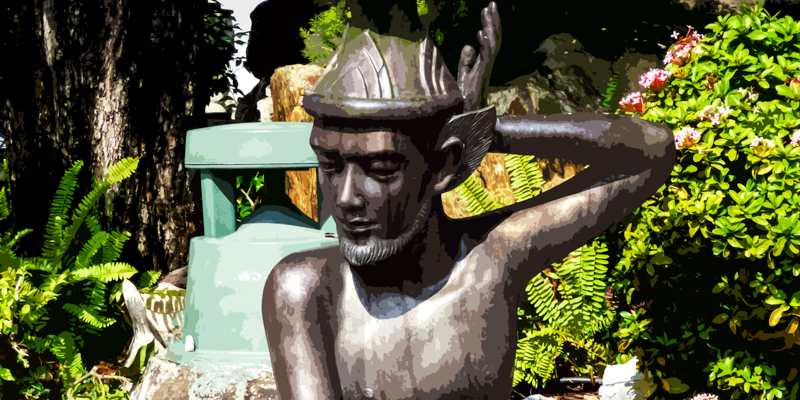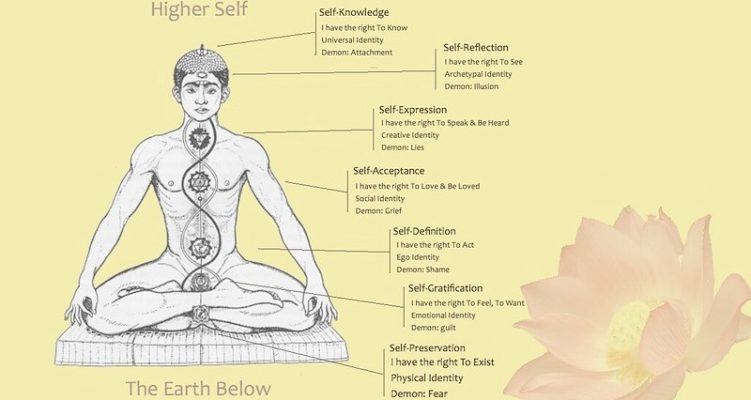
Tummo Breathing is a Tibetan Buddhist-Tantric breathing technique, a type of Pranayama, or perhaps better — a breathing meditation.
The actual goal of carrying out the technique is about activating the Chakras, awakening Kundalini Energy, creating the ideal state or condition for “meditation on emptiness,” and finally achieving Divine Union and Spiritual Bliss.

In Tibetan Buddhism, Tummo is the Goddess of heat and passion. On a practical level then, Tummo Breathing is the Tantric practice of increasing “inner heat” or “inner fire” in order to arouse and circulate Vital Life Force through the Energy Channels (Nadis), notably through the primary Avadhuti Channel, which is the Tibetan equivalent of Sushumna Nadi in Indian Yogic concepts.
As with many Tibetan Tantra practices, visualization is an important aspect while performing exercises. In this case, it’s the visualization of a flame or fire rising up along the spine i.e. the Avadhuti Channel, which finally spreads across the body. Mind that the practice indeed can raise both the body’s temperature and heart rate.
Nevertheless, some think that — on a more down-to-earth level — the technique was also used to simply elevate one’s body temperature to keep the body warm in the extremely cold Tibetan weather conditions. Additionally, it’s said that it also “ignites the mind,” thereby increasing concentration ability and cognitive functions.
Other health benefits attributed to the technique are increased stress management, relief of anxiety and depression, a better functioning immune system, improved physical and mental endurance, and an improved respiratory and cardiovascular performance.

In any case, the type of breathing used is also called Vase Breathing — an Abdominal Breathing technique — which in Tummo Breathing is performed rather intense and energetic. Mind, however, that there are variations of how to actually do this, and moreover it’s a rather complicated technique if you would follow the ancient Tibetan scriptures describing it.
It’s called Vase Breathing because it involves holding the breath after a deep inhale while pushing it down “by swallowing” into the belly (which then initially protrudes), in a way that creates a “container form” i.e. “vase form” in the abdominal and diaphragmatic area. In fact, in Vase Breathing one contracts the perineal, pelvic, and abdominal muscles so that the protruding lower belly takes a vase or pot shape.
After holding one’s breath as long as possible (which then further heats “the fire” in the navel area, and pushes Prana Life Energy through the Energy Channels), one forcefully exhales to fully empty the lungs. Mind that in some versions of Tummo Breathing exhaling is not done forcefully but rather gently. As one breathes out, one visualizes the heat shooting up from the navel area to the top of the head and radiating to the rest of the body.
A Tummo Breathing session typically unfolds by first visualizing the Energy Channels (Nadis) in the body, next one “builds a fire” in the belly just under the navel area, and finally one applies Vase Breathing, which is then performed several times.
To give you the idea, below we cite a description of how to perform Inner Heat Meditation (tum-mo) as found on the Tibetan Buddhist Encyclopedia website.

“Sit comfortably in your meditation place and generate a strong positive motivation for doing this inner heat practice. Determine to keep your mind relaxed, concentrated and free of expectations for the entire session.
Start by visualizing the central channel (Sushumna) as a transparent, hollow tube, a finger’s breadth in diameter. It runs straight down through the center of the body, just in front of the spinal column, from the crown of your head to the base of your spine.
Next, visualize the right and left lateral channels (Nadis), slightly thinner than the central one. They start from the right and left nostrils respectively, travel upwards to the top of\ the head and then curve over to run downwards on either side of the central channel. They curve inwards and join the central channel at a point approximately four fingers breadth below the level of the navel.
Take as long as you like to construct this visualization. Once it is stable, imagine a red-hot ember the size of a tiny seed inside the central channel at the level of the navel. To strengthen this visualization, imagine reaching into a fire, taking out a tiny glowing ember and placing it in your central channel. Once it is there, really feel its intense heat.
Now, in order to increase the heat, gently contract the muscles of the pelvic floor, concentrating on the internal rather than the external muscles, and in this way bring air energy up from the lowest chakra (energy wheel or center) to the ember.
Next, gently take a full breath through the nostrils. The air travels from the nostrils through the right and left channels to where they enter the central channel just below the level of the navel. The air joins with the heat there and with energy brought up from below.
As you stop inhaling, immediately swallow and push down gently with your diaphragm in order to firmly compress the energy brought down from above: now the air energy is completely locked in, compressed from above and below.
Now, hold your breath as long as it is comfortable to do so. Concentrate completely on the ember in the navel area, whose heat is increasing and spreading as a result of the compressed air energy.
When you are ready, relax your lightly tensed muscles and exhale gently and completely. Although the air leaves through the nostrils, visualize that it rises up through the central channel and dissolves there. The heat emanating from the burning ember at the navel continually increases and spreads and starts to burn away the blockages at each chakra and starts also to warm the concentration of silvery blissful energy found at the crown chakra.
However, the focal point of your concentration is always the heat of the burning ember in the navel area. Once your first exhalation is complete, again tighten the lower muscles, inhale a second time, swallow and push down with diaphragm, thus again compressing the air on the heat, then exhale, releasing the air up the central channel once again.
Repeat the entire cycle rhythmically seven times altogether, the intensity of the heat growing with each breath.
At the seventh exhalation, imagine that the now burning-hot ember explodes into flames. They shoot up the central channel, completely consuming and purifying the delude energy at each chakra. At the crown, the flames finally melt and release the silvery blissful energy, which pours down the purified central channel giving pleasure at each chakra it passes.
Finally, when it meets the blazing ember at the navel chakra, there is an explosion of bliss. This blissful heat flows out to every atom and cell of your body, completely filling you, making your mind very happy.
Concentrate on this pleasure without tension or expectation, without clinging to it or analyzing it. Just relax and enjoy it.
You will notice that, no matter how strong the pleasure is, your mind and body are calm and controlled, unlike our usual experiences of physical pleasure when the mind is excited and uncontrolled.
If your mind should wander from its concentration to other objects – the past or future, objects of attachment or aversion- focus your attention on the subject of the thought, the mind that perceives the distracting object, the thinker. Watch the subject until the distracting thought disappears, then concentrate again on the blissful feeling.
Analysis of feeling: Having reached a state of clarity, it is good to use it to discover the nature of your mind. After concentrating on your feeling, being absorbed in it for some time, analyze it by contemplating each of the following questions. Take as long as you like.
Is the feeling permanent or impermanent? How? Why? Is the feeling blissful or suffering? How? Why? Is the feeling related or unrelated to the nervous system and in the mind? How?Why? Does the feeling exist inherently, from it own side, without depending on anything else, or not? How? Why?
Examine each point from every angle. Finish the session by summing up your conclusion, and then dedicate any positive energy and insight gained during the meditation to your speedy enlightenment for the sake of all living beings.”














